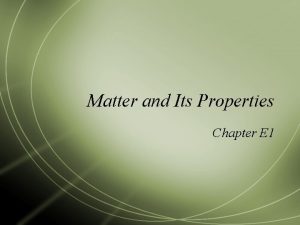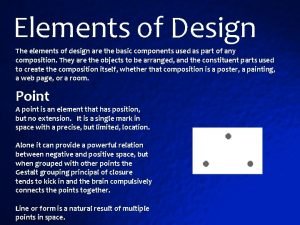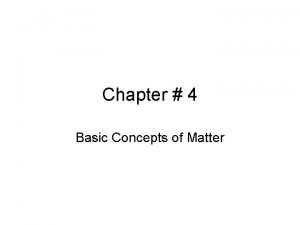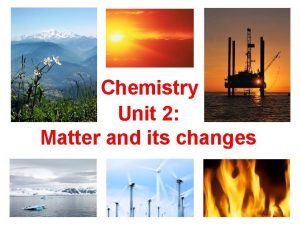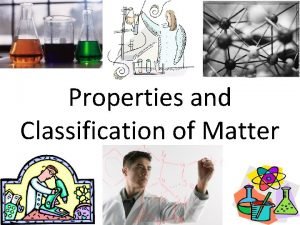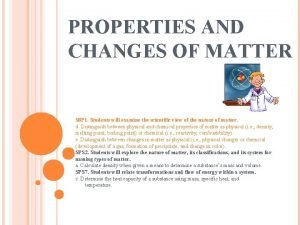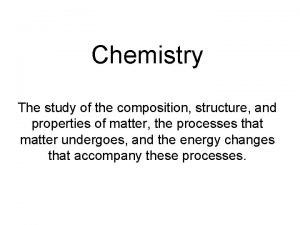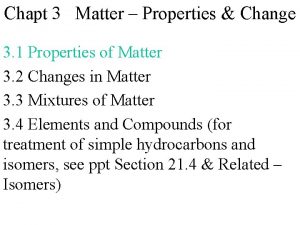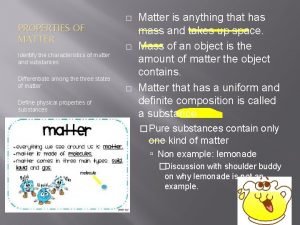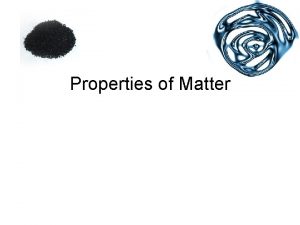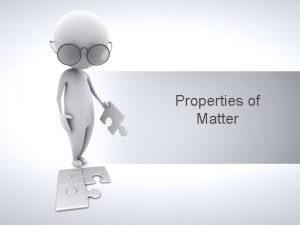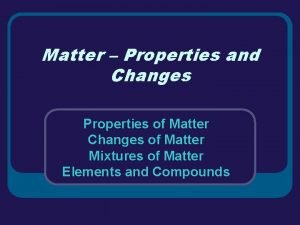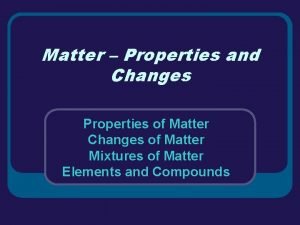Matter and its properties Matter defined Matter is
















- Slides: 16

Matter and its properties

• Matter defined: – Matter is anything that has mass and takes up space • Volume defined: – The amount of space an object takes up • Units expressed as m. L, or cm cubed

Mass and Weight, What’s the difference • Mass is the amount of matter in an object. – Unit expressed by grams – Always constant, never changes • Weight is a measure of the gravitational force exerted on an object. – Unit expressed in Newtons (N) – Can change, depending on the objects location in the universe.

Physical Properties of Matter • Let’s play 20 questions!

Identifying Matter • Thermal Conductivity – The rate at which a substance transfers heat.

Identifying Matter • Density – The mass per unit volume of a substance, or m/v • Lead is a very dense metal • Solubility – The ability of a substance to dissolve in another substance

Identifying Matter • Ductility – The ability of a substance to be pulled into a wire. • Malleability – The ability of a substance to be rolled or pounded into thin sheets

Identifying Matter • State – The physical form in which a substance exists, such as a solid, liquid, and gas

New State! • Let me introduce you to the fourth state of matter: – PLASMA

Physical Changes • A physical change is a change that affects one or more physical properties of a substance, but does not change the identity of the matter involved. Many Physical changes can be reversed.

Chemical Properties • Chemical properties describe matter based on its ability to change into new matter that has different properties. – Examples: Wood has the chemical property of flammability, because it can burn. – Ash and smoke can not burn, so they have the chemical property of nonflammability.

• More Examples of Chemical Properties – Reactivity: the ability of two or more substances to combine and form one or more new substances

Physical and Chemical Properties

Chemical Changes • A chemical change happens when one or more substances are changed into new substances that have new and different properties. -The statue of liberty was originally orange, because it is made of copper. Copper is reactive with oxygen, it turns green.

How do you know if a Chemical Change has occurred? • Indication a chemical change has occurred: – Change in color – Odor – Production of heat – Fizzing or foaming – Sound or light • Almost all chemical changes are irreversible, like baking a cake. Electrolysis is an example of one that can be reversed – The method of sending an electric current into water, so it can split and form hydrogen and oxygen

 Matter and its properties
Matter and its properties Is a collection of well defined objects
Is a collection of well defined objects Is an element defined by its perimeter, a closed contour
Is an element defined by its perimeter, a closed contour Matter is defined as anything that
Matter is defined as anything that The emigree by carol rumens
The emigree by carol rumens Its halloween its halloween the moon is full and bright
Its halloween its halloween the moon is full and bright Properties of triangle project
Properties of triangle project Lesson 6-6 trapezoids and kites answers
Lesson 6-6 trapezoids and kites answers Extensive properties and intensive properties
Extensive properties and intensive properties Chemical property definition
Chemical property definition Definition of substance
Definition of substance Properties of solid liquid and gas
Properties of solid liquid and gas Classification and properties of matter
Classification and properties of matter Properties and changes of matter worksheet
Properties and changes of matter worksheet Study of composition structure and properties
Study of composition structure and properties Matter-properties and changes answer key
Matter-properties and changes answer key Properties and characteristics of matter
Properties and characteristics of matter
